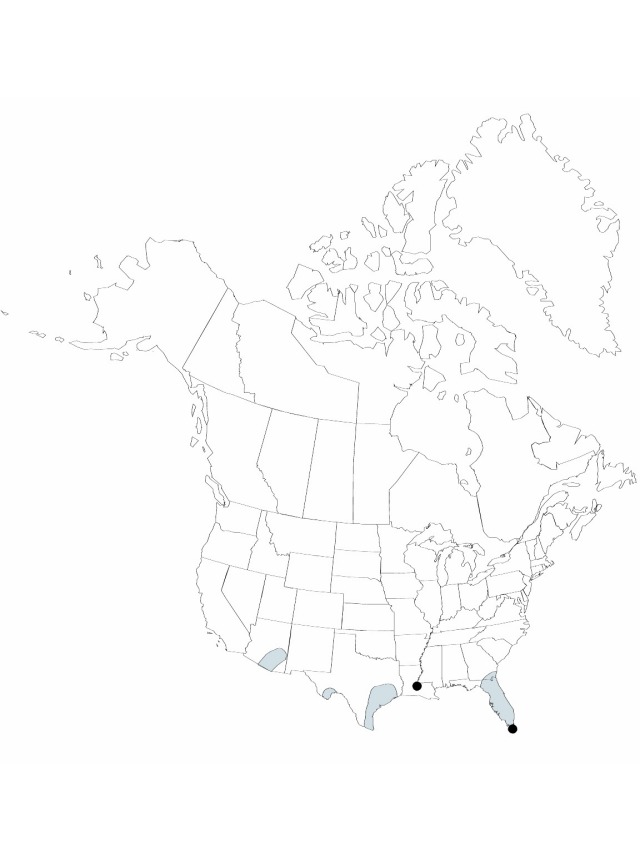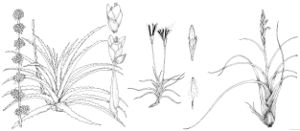Difference between revisions of "Tillandsia recurvata"
Sp. Pl., ed. 2 1: 410. 1762.
FNA>Volume Importer |
imported>Volume Importer |
||
| (5 intermediate revisions by 2 users not shown) | |||
| Line 8: | Line 8: | ||
}} | }} | ||
|common_names=Ball-moss | |common_names=Ball-moss | ||
| − | |basionyms={{Treatment/ID/ | + | |special_status={{Treatment/ID/Special_status |
| + | |code=F | ||
| + | |label=Illustrated | ||
| + | }} | ||
| + | |basionyms={{Treatment/ID/Basionym | ||
|name=Renealmia recurvata | |name=Renealmia recurvata | ||
|authority=Linnaeus | |authority=Linnaeus | ||
| + | |rank=species | ||
| + | |publication_title=Sp. Pl. | ||
| + | |publication_place=1: 287. 1753 | ||
}} | }} | ||
|synonyms={{Treatment/ID/Synonym | |synonyms={{Treatment/ID/Synonym | ||
|name=Diaphoranthema recurvata | |name=Diaphoranthema recurvata | ||
|authority=(Linnaeus) Beer | |authority=(Linnaeus) Beer | ||
| + | |rank=species | ||
}} | }} | ||
|hierarchy=Bromeliaceae;Tillandsia;Tillandsia recurvata | |hierarchy=Bromeliaceae;Tillandsia;Tillandsia recurvata | ||
| Line 38: | Line 46: | ||
-->{{#Taxon: | -->{{#Taxon: | ||
name=Tillandsia recurvata | name=Tillandsia recurvata | ||
| − | |||
|authority=(Linnaeus) Linnaeus | |authority=(Linnaeus) Linnaeus | ||
|rank=species | |rank=species | ||
| Line 52: | Line 59: | ||
|publication title=Sp. Pl., ed. 2 | |publication title=Sp. Pl., ed. 2 | ||
|publication year=1762 | |publication year=1762 | ||
| − | |special status= | + | |special status=Illustrated |
| − | |source xml=https:// | + | |source xml=https://bitbucket.org/aafc-mbb/fna-data-curation/src/2e0870ddd59836b60bcf96646a41e87ea5a5943a/coarse_grained_fna_xml/V22/V22_433.xml |
|genus=Tillandsia | |genus=Tillandsia | ||
|species=Tillandsia recurvata | |species=Tillandsia recurvata | ||
Latest revision as of 20:31, 5 November 2020
Plants in dense spheric clusters, flowering to 15 cm diam. Stems short. Leaves 4–10, 2-ranked, recurving, gray, 6–12 × 0.2–0.3 cm, densely pruinose-scaly; sheath pale, elliptic, not inflated, not forming pseudobulb, 4–8 mm wide; blade subulate, terete distally, succulent, margins involute to nearly tubular, apex acute to attenuate. Inflorescences: scape conspicuous, erect, 2–5 cm, ± 1 mm diam.; bracts 1–2, widely spaced, erect, inconspicuous, nearly foliaceous; sheath of bracts narrowing gradually into blade; spikes ascending, subpalmate, elliptic, compressed, 8–15 ´ 4–6 mm, apex acute; lateral branches absent. Floral bracts laxly imbricate, erect, green, tinged purple, broad (covering all or most of rachis, rachis not visible at anthesis), narrowly elliptic, not keeled, 0.8–1 cm, thin-leathery, apex acute, surfaces densely grayish-scaly, venation even to slight. Flowers usually 2, conspicuous; sepals free, lanceolate, not keeled, 6–8 mm, thin, veined, apex acute, surfaces glabrous; corolla tubular; petals spreading toward apex, violet, elliptic, 0.7–1 cm; stamens included; stigma included, simple-erect. Fruits to 3 cm.
Phenology: Flowering summer.
Habitat: Epiphytic to occasionally among or on rocks (Arizona, Texas), usually in bright exposed habitats
Elevation: 0–1500 m
Distribution

Ariz., Fla., Ga., La., Tex., Mexico, West Indies, Central America, South America.
Discussion
Selected References
None.
